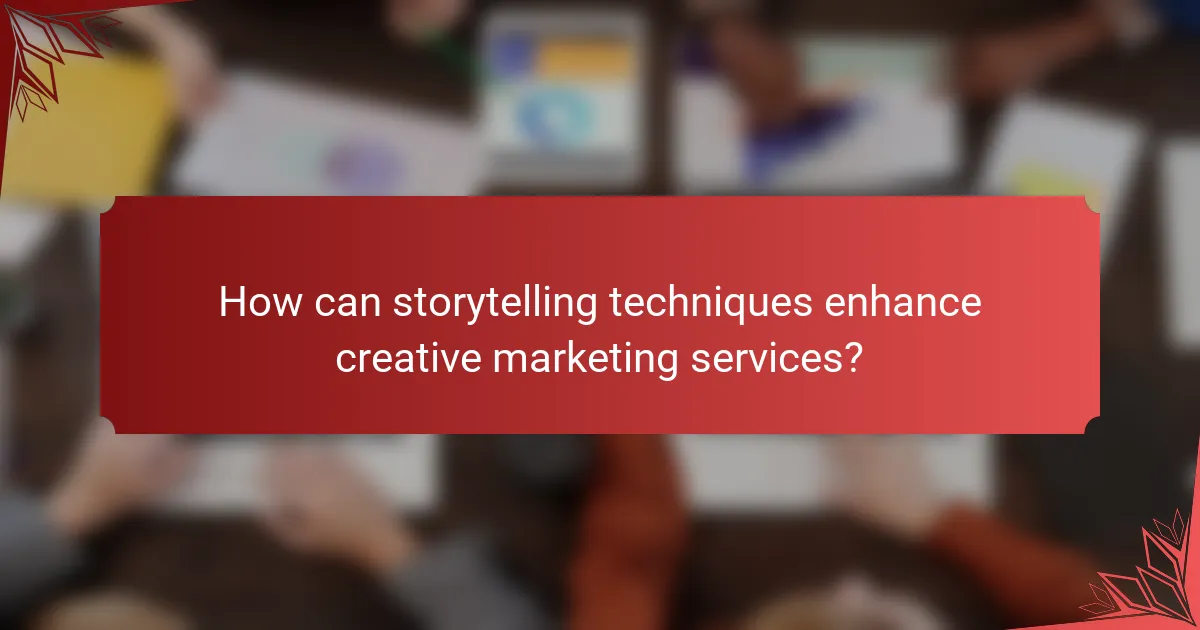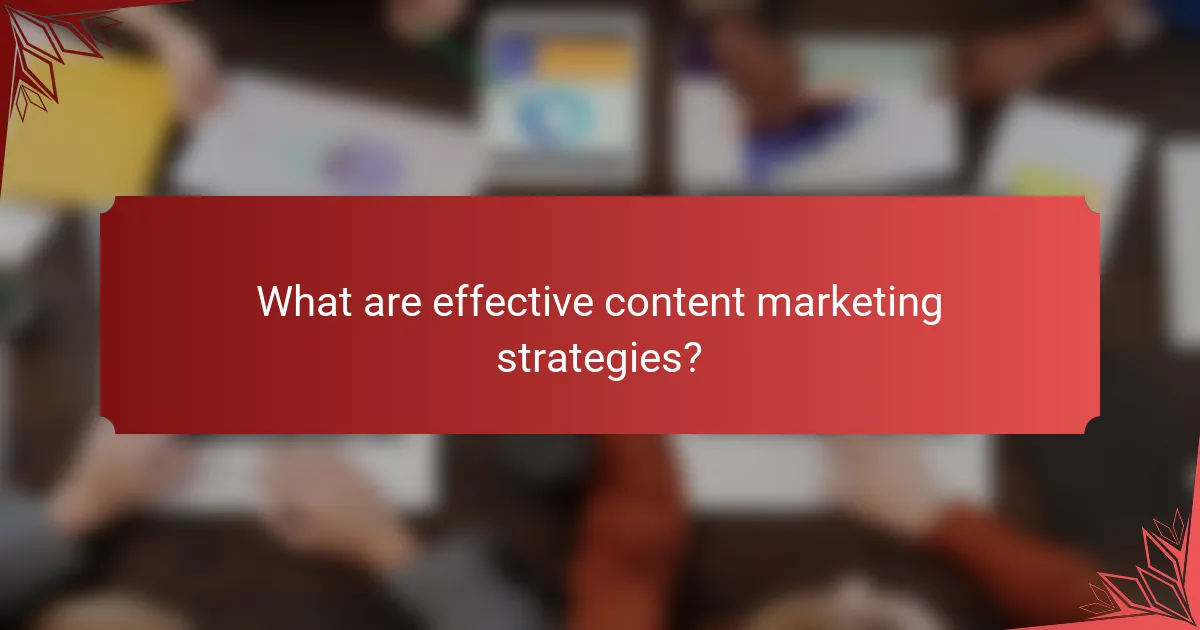Creative marketing services leverage storytelling techniques to forge deeper connections with audiences, allowing brands to evoke emotions and stand out in a competitive landscape. By focusing on valuable content that resonates with target demographics, businesses can drive engagement and foster loyalty. Understanding audience needs and preferences is crucial, enabling marketers to craft personalized messages that truly connect.

How can storytelling techniques enhance creative marketing services?
Storytelling techniques can significantly enhance creative marketing services by fostering deeper connections with audiences. By weaving narratives into marketing strategies, brands can evoke emotions, create memorable experiences, and differentiate themselves in a crowded marketplace.
Emotional engagement through narratives
Emotional engagement is crucial in marketing, as it helps brands resonate with their audience on a personal level. By using storytelling, marketers can tap into feelings such as joy, nostalgia, or empathy, making their messages more impactful. For instance, a brand might share a customer’s success story, illustrating how their product made a difference in that person’s life.
To effectively engage emotions, consider the following tips: focus on relatable characters, create conflict or challenges, and highlight resolutions that showcase the brand’s value. This approach not only captivates the audience but also encourages them to share the story, amplifying its reach.
Building brand identity with stories
Stories play a vital role in shaping brand identity by conveying core values and mission in a relatable manner. A strong narrative can help consumers understand what a brand stands for, fostering loyalty and trust. For example, a sustainable fashion brand might share its journey of ethical sourcing, illustrating its commitment to environmental responsibility.
To build a compelling brand identity through storytelling, ensure that your narratives align with your brand’s values and resonate with your target audience. Consistency in storytelling across various platforms reinforces brand recognition and helps establish a cohesive image.
Case studies of successful storytelling
Numerous brands have successfully leveraged storytelling techniques to enhance their marketing efforts. For instance, Nike’s “Just Do It” campaign uses inspirational stories of athletes overcoming challenges, which not only promotes their products but also connects emotionally with consumers.
Another example is Coca-Cola’s “Share a Coke” campaign, where personalized bottles encouraged customers to share their experiences. This initiative not only boosted sales but also created a community around the brand, demonstrating the power of storytelling in fostering audience connection.

What are effective content marketing strategies?
Effective content marketing strategies focus on creating valuable, relevant content that engages the target audience and drives profitable customer action. Key components include SEO-driven content creation, social media distribution, and performance measurement to optimize outcomes.
SEO-driven content creation
SEO-driven content creation involves developing content that is optimized for search engines to increase visibility and attract organic traffic. This includes using relevant keywords, crafting compelling meta descriptions, and ensuring proper formatting for readability.
To enhance SEO, consider creating content that answers common questions in your industry, using tools like Google Keyword Planner to identify popular search terms. Aim for a mix of long-form articles and shorter posts to cater to different audience preferences.
Utilizing social media for distribution
Utilizing social media for distribution means sharing your content across platforms like Facebook, Twitter, and LinkedIn to reach a broader audience. Each platform has its unique audience and best practices, so tailor your messaging accordingly.
For example, use eye-catching visuals on Instagram, while LinkedIn may require a more professional tone. Regularly engage with your audience through comments and shares to foster community and encourage further distribution of your content.
Measuring content performance
Measuring content performance is crucial for understanding the effectiveness of your marketing strategies. Key metrics include website traffic, engagement rates, and conversion rates, which help assess how well your content resonates with the audience.
Utilize tools like Google Analytics to track these metrics over time. Set specific goals for each piece of content, such as increasing newsletter sign-ups or boosting social shares, and adjust your strategies based on the data collected to improve future campaigns.

How to connect with your audience through marketing?
Connecting with your audience through marketing involves understanding their needs and preferences, then crafting messages that resonate. Effective strategies include utilizing storytelling, personalization, and engaging feedback mechanisms.
Understanding audience demographics
To effectively connect with your audience, start by analyzing their demographics, such as age, gender, income, and location. This data helps tailor your marketing strategies to meet the specific interests and needs of different segments.
Utilize tools like surveys or analytics platforms to gather demographic information. For instance, if targeting millennials, consider platforms like Instagram or TikTok, while older audiences may prefer Facebook or email newsletters.
Personalization techniques in campaigns
Personalization in marketing campaigns enhances audience connection by delivering tailored content. Techniques include using the recipient’s name in communications, recommending products based on past purchases, or creating targeted ads that reflect individual preferences.
Consider implementing dynamic content on your website that changes based on user behavior. For example, an e-commerce site could show different products to returning visitors compared to first-time users, increasing the likelihood of conversion.
Feedback loops for audience engagement
Establishing feedback loops is crucial for ongoing audience engagement. Encourage customers to share their opinions through surveys, social media interactions, or product reviews, and ensure you respond to their input.
Regularly analyze feedback to identify trends and areas for improvement. For example, if multiple customers mention a specific issue with a product, addressing it promptly can enhance customer satisfaction and loyalty.

What are the key components of a successful marketing campaign?
A successful marketing campaign hinges on several key components, including clear objectives, the right channels, and effective budget allocation. These elements work together to ensure that the campaign resonates with the target audience and achieves desired outcomes.
Defining clear objectives
Establishing clear objectives is crucial for guiding a marketing campaign. Objectives should be specific, measurable, achievable, relevant, and time-bound (SMART). For example, a goal could be to increase website traffic by 20% over three months.
When defining objectives, consider the overall business goals and how the marketing campaign can support them. This alignment ensures that efforts contribute to broader organizational success.
Choosing the right channels
Selecting the appropriate channels for your marketing campaign is essential for reaching your target audience effectively. Common channels include social media, email, content marketing, and paid advertising. Each channel has its strengths; for instance, social media is great for engagement, while email marketing excels in direct communication.
Evaluate your audience’s preferences and behaviors to determine which channels will be most effective. It may be beneficial to use a mix of channels to maximize reach and impact.
Budget allocation strategies
Effective budget allocation is vital for optimizing the resources of a marketing campaign. Start by determining the total budget and then divide it among various channels based on their expected return on investment (ROI). For example, if social media ads have historically performed well, allocate a larger portion of the budget to that channel.
Regularly review and adjust the budget based on performance metrics. This flexibility allows you to invest more in high-performing areas while scaling back on less effective strategies. Aim for a balanced approach that supports both short-term and long-term marketing goals.

How to choose the right creative marketing service?
Choosing the right creative marketing service involves evaluating their expertise, understanding their offerings, and assessing their past performance. Focus on agencies that align with your specific goals and have a proven track record in your industry.
Evaluating agency portfolios
When evaluating agency portfolios, look for a diverse range of projects that showcase creativity and effectiveness. Check for case studies that highlight successful campaigns, particularly those similar to your needs.
Consider the visual style and messaging consistency across their work. An agency’s portfolio should reflect their ability to connect with audiences and tell compelling stories.
Assessing client testimonials
Client testimonials provide insight into an agency’s reliability and effectiveness. Look for reviews that detail specific outcomes, such as increased engagement or sales, rather than vague praise.
Seek testimonials from clients in your industry to gauge how well the agency understands your market. Platforms like Clutch or Google Reviews can be useful for finding authentic feedback.
Understanding service offerings
Understanding the service offerings of a creative marketing agency is crucial for ensuring they meet your needs. Common services include content marketing, social media management, and branding strategies.
Ask about their approach to storytelling and audience engagement, as these are key components of effective marketing. Ensure that their services can be tailored to fit your specific objectives and budget.

What are the benefits of integrating storytelling in content marketing?
Integrating storytelling in content marketing enhances engagement and builds a deeper connection with the audience. By weaving narratives into marketing strategies, brands can create memorable experiences that resonate emotionally, leading to increased loyalty and conversion rates.
Increased audience retention
Storytelling significantly boosts audience retention by making content more relatable and engaging. When consumers encounter a narrative that resonates with their experiences or aspirations, they are more likely to remember the brand and its message.
To maximize retention, brands should focus on crafting authentic stories that reflect their values and mission. For example, a company could share customer success stories that highlight how their product solved a problem, creating a personal connection that keeps the audience coming back.
Additionally, using various formats like videos, podcasts, or blog posts can cater to different preferences, ensuring that the storytelling approach reaches a broader audience. Consistency in storytelling across platforms also reinforces brand identity and helps maintain audience interest over time.
